Desertification
July 29, 2008
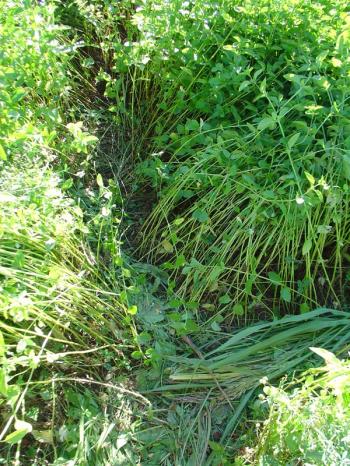
But before there was desertification, there was humidification. A path sketched through the bergamot.
This is a painful entry for me to write because I’m suffering from a garden identity crisis. I started out this morning wanting to say something about the humidifying effect of planting green manures/cover crops and the desertification that ensues when I remove these covers to plant the ‘real’ crops. These eventually grow big, fill out, provide shade, and re-humidify the soil again. But in my garden ‘desertification’ has taken on another meaning, namely that I regularly desert my garden for months at a time, often in planting seasons, and allow the green manures to grow too large, requiring labour intensive transplant therapy upon my return.
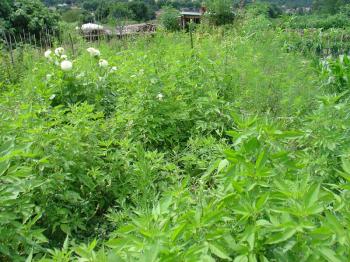
Before: a beautiful yet unproductive wilderness, or a garden gone to hell in a handbasket?
At this time of the year down at the kitchen gardens, everyone is enjoying harvesting an abundance of summer produce. Neighbour Pedro has grown monster pumpkins, big and round like his wife. Row after row of only 12 sorts of vegetables border my 1,50 meter high mess of… cover crop. On the other side, Sidi El Gouche is already into his third harvest. He’s digging up crates of potatoes and planting swimming pool-sized beds of coriander in the shade of his fig. He’s got crispy croquante lettuces, plenty of onions and corn, and the watermelons trail along the back end at the edge of Caizergue’s sand field. Bordering my hot mess of permaculture, El Gouche has three long rows of heavily laden raspberries lazily leaning against bamboo racks.
And I have alfalfa. And fuqn excellent soil.
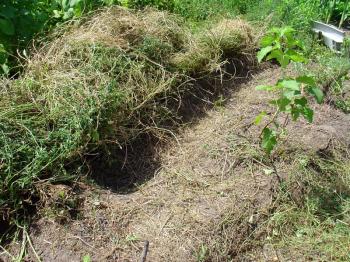
After rolling back only two rows of alfalfa, I’ve produced a hay mat and a desert. Once my ‘real crop’ seedlings can see over the top, I’ll put the flattened hay mat back on the beds to prevent weeds and to rot into new soil.
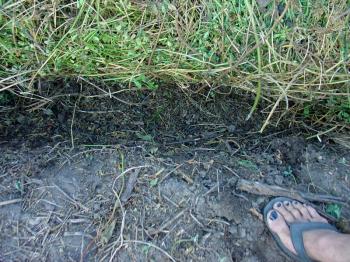
Under the alfalfa mat, pure rotted goodness
When I left the garden last March, it was still too cold to plant vegetable seedlings and I had strewn alfalfa to grow as a dirt-enriching live mulch. You reap what you sow, and in my nearly 160m2 of kitchen garden, with my obsession for soil health and richesse, I had sowed alfalfa amidst the plants that I abandon each time the work calls me back up North; dahlias, rhubarb, sorrel, horseradish, strawberries, raspberries, currants, lavender, the other flowers, the other herbs, and the stick forests of mint and bergamot that line my water channels.
I thought I’d be back a bit after the Ice Saints to plant the seedlings of proper vegetables that humans like to eat, but my projects kept me away for more than 4 months. So when I arrived mid July, I encountered a jungle of alfalfa tangle so thick that I was unable to walk through it. On the upside, there were also clouds of bees feasting on beautiful blue and purple flowers and because the ‘weeds’ I had planted had grown so big, they had done a good deal of ‘pre-weeding’ by elbowing out the others. I should also mention that treading on alfalfa and bergamot produces wafts of smile-inducing summer perfume.
Each time I return after deserting my garden for a long time, it’s always the same. My neighbours turn up to check out my reaction to the abundant plant growth, and my friends roll their eyes and say, ‘I knew you’d call it that’, each time I use the word biomass when referring to the intentionally planted weeds I mean alfalfa.
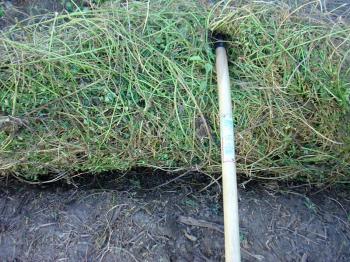
The bottom of the alfalfa roll looks like lace. Fresh, it’s 60cm thick. Dried, 20cm. It will rot away in a season increasing soil by 5cm.
Although beautiful, my garden is not producing much in the way of edibles because I had neglected to plant any in April (or May, or June). Instead I planted alfalfa in March. And this I repeatedly tell myself, so as not to feel terrible that my harvest this summer consists essentially of one hella fat wad of hay mulch and good soil (well there’s also the berries and the sorrel). The neighbours stand around asking when I’m going to put all that fabulous soil to good use.
The garden is lush, and my feet get wet at the bottom of the plant canopy, like in a miniature rain forest. Because I have free and unlimited water (for the time being) and neighbour Sidi El Gouche willing to water for me (Insha’Allah), I cannot be certain, but I believe that planting this way increases the soil’s ability to retain moisture. Indeed, it is hummus-rich and still wet. Under the plant cover, the sticks I laid down on the yet unplanted beds have rotted and kept the shaded beds completely weed-free. The tilth is exceptional and you could dig with your bare hands if you wanted to. Before planting the seedlings, I part a path through the biomass with my arm and roll back the alfalfa into a giant, ‘felted plant mat’. The ‘other’ desertification of my garden begins and it sucks up all of my upper body strength.
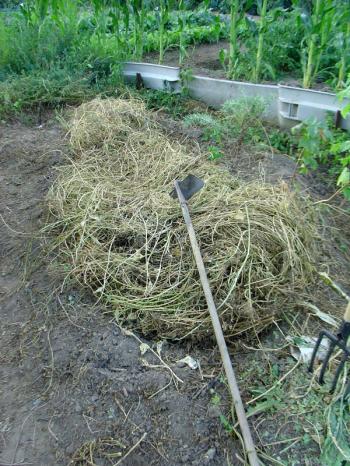
The rolled alfalfa hay mat drying in the canal, in the distance, Pedro’s productive potager
Maybe I should simply accept that by deserting my garden for so long, a harvest comprised of experiments with ground covers, live-mulching, humus richesse and huge quantities of organically grown and artisanally hand-rolled hay matting is an excellent harvest. But it remains embarrassing that the three gardeners whose plots border mine, and who essentially grow hydroponically with chemical fertilisers on pale coloured sand, produce basket upon basket of vegetables and fruit. Delicious vegetables and fruit.
Which they most generously give to me; bag upon bag of testerone-steeped chard, lettuce, sweet onions, and monster zucchinos. And I have nothing to give them in return, unless you consider the opportunity to gossip about the crazy lady and her deserted permaculture garden a generous trade. Comment dit-on ‘potager conceptuel’?
In the 4 months that it needs me most, I regularly abandon my garden to play busy-busy 1100 kilometers away. I wink and call my garden a permaculture garden, but lest I give it a bad name, I should probably state that permaculture does not mean deserting your plantings and letting your garden go to pot.
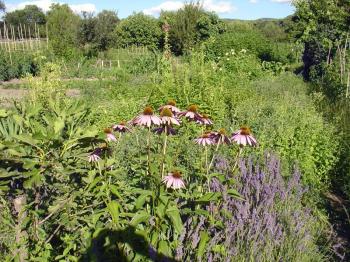
Self portrait w/garden going to pot. Jolie, non?
debra at 12:56 | | post to del.icio.us

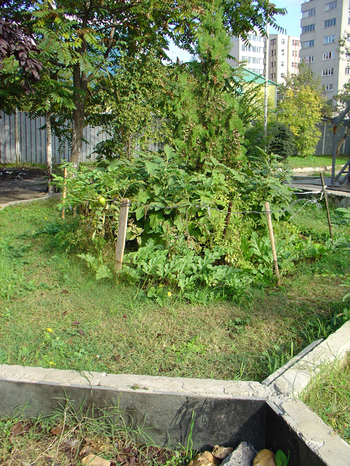
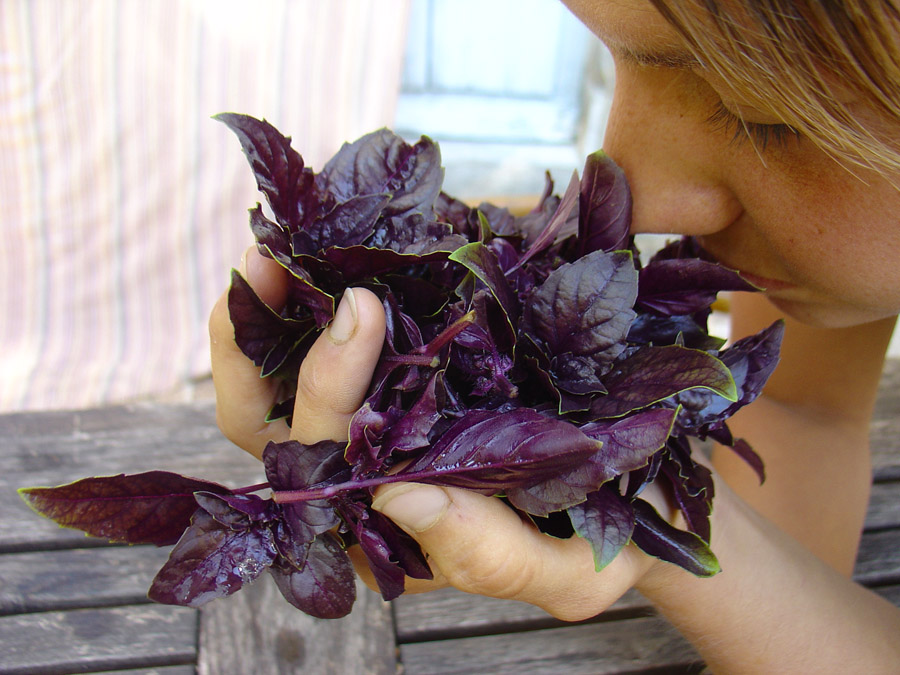
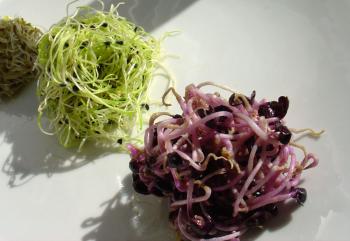
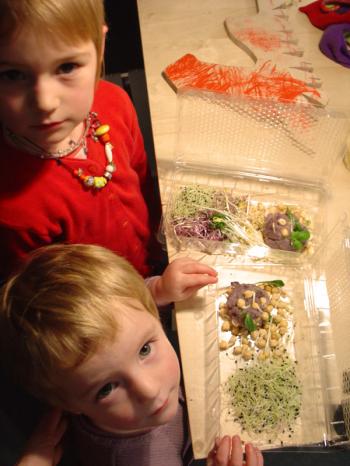
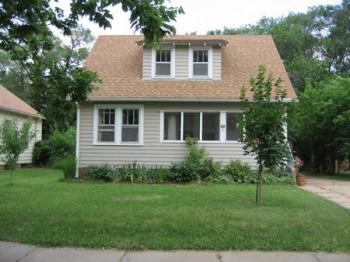

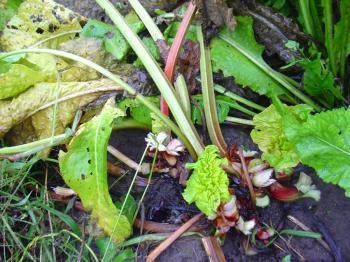










Why don’t you get some more dang perennials in there? Besides the berries and the sorrel, there must be some very productive food weeds that will take care of themselves for 4 months and be ready to harvest on your return. I’m quite partial to jerusalem artichoke myself.
I am envious of your unlimited water. I am in south-eastern Australia. It is dry here. I was agog at your channels of water. I wouldn’t know what to do with that much water.
Comment by Sam — July 29, 2008 @ 14:04
Well this is what I’m wondering. What if I just grew the alfalfa covercrop (with its 1 meter deep tap root) which would shade the other plants.
I’ve got too many things mixed in, but I could experiment cutting off a canal and its beds from water and see what happens, if the cover crop functions to humidify the soil sufficiently.
There are growers that I’ve read about that grow with little or no irrigation.
Comment by debra — July 29, 2008 @ 14:08
I’m no expert, but I’m amazed with what can be accomplished with mulching. My garden can go for weeks without watering, when there’s no rainfall in spring and autumn. I haven’t dared try for that in the height of summer though. The vegetables are too precious. I’m not sure where you are but you’d be able to rely on some rain?
I usually use dry mulch, but I like the idea of alfalfa as a living cover crop. You’d probably get better results with a well established perennial crop, something that could withstand a dry spell.
Have you seen that video on greening the desert? http://permaculture.org.au/?p=230
Comment by Sam — July 30, 2008 @ 14:37
From my experience… alfalfa works great as a living cover crop as long as it doesn’t grow disproportionately larger than the other plants.
I’m going to try fenugreek - because I like the way it looks and it has similar properties to clover, although I don’t have any experience with it yet.
In my Amsterdam kitchen garden (25m2 - started this July, so it’s too young to tell) I planted it. BUt that is my first experience gardening so far North, so I’m curious what has happened IN MY ABSENCE WHEN I’M DOWN HERE.
I’m looking for a ‘lower’ cover crop - and clover is working here, but is very invasive, still - that’s my own garden psychology, in fact, it’s working GREAT.
Maybe I should leave it in some places to see what happens. I didn’t plant it, it was just there.
Comment by Debra van Culiblog — July 30, 2008 @ 14:46
Sam,
Thanks for the link to the OZ PRI. very inspiring because I’m going to do a project relatively close to there in Ein Hud in a Palestinian village. It’s a farmer’s market project, but will also in later phases of the project address the farming issues there (and their lack of legal water). I’m looking to find information about permaculture written in Arabic and Hebrew.
Issues in Ein Hud will be:
- water harvesting
- simple grey water filtering (if culturally acceptable)
- possibly dry toilets (if culturally acceptable)
- permaculture, no-till
- live-mulching and mulching
Do you know of any STUDIES about LIVE vs DRY mulch? Which is more water efficient? I’m just going on my own observations - which say that LIVE mulching is better = wetter. But I would be curious to hear from someone with a bit more experience and… more at stake, in short, an actual farmer.
Comment by Debra van Culiblog — July 30, 2008 @ 15:00
“Big and round like my wife” eh? I think I just had a good idea about somewhere dark - and mobile - to store my pumpkins for the winter. See you later.
Comment by Pedro — July 31, 2008 @ 9:17
hey Debra, waar is jouw tuin? In noord?
Ik kan je wel een keer meenemen naar mijn tante in MiddenBeemster die daar ecologisch tuiniert met een enorme moestuin vol met groenten en bloemen. Voor tips en weet-ik-veel.
Comment by rob — July 31, 2008 @ 17:15
Hi Rob,
Heel onhandig, maar ik heb er twee. Één in Noord (vlak over de pont), en de andere, die nu is afgebeeld, is in Zuid Frankrijk. Super onhandig.
Maar ik vind het erg lief aangeboden en ga graag een keertje mee naar jou tante in de MiddenBeemster. Wat leuk, een UITJE!
Graag - want in het Zuide, gaat het wel - alles groeit, maar in het Noorde, heb ik geen ene aanung. Dit is de eerste keer ik zo noordelijk tuineer. Daarvoor was ZuidFrankrijk, en daarvoor was Californië - die eigenlijk op de hoogte graad is van ZuidSpanje.
Bedankt Rob!
Comment by debra — July 31, 2008 @ 21:14